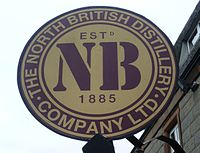North British Distillery
 |
|
| Private | |
| Industry | Distillery, Scotch whisky |
| Founded | 1885 |
| Founder | Andrew Usher, William Sanderson, John M. Crabbie |
| Headquarters | Gorgie, Edinburgh, Scotland |
|
Number of locations
|
Gorgie, Edinburgh Addiewell, West Lothian |
|
Area served
|
Scotland |
| Products | Pure grain alcohol |
|
Number of employees
|
1500 |
| Parent | Lothian Distillers (50/50 joint venture between Diageo/Edrington Group) |
| Website | NorthBritish |
The North British Distillery Company Ltd is a Scottish grain whisky distillery located in south western Gorgie district of Edinburgh. Established by a group of independent distillers in 1885, it is now a joint venture company between Diageo plc and the privately held Edrington Group. It is Edinburgh’s last working distillery, widely known as "NB".Tynecastle Stadium lies immediately to the southeast.
With grain whisky consumption growing in the industrialised and railway connected Victorian era, independent distillers needed access to a high quality and high volume producer of pure grain alcohol.
In 1885, major shareholders Andrew Usher, William Sanderson and John M. Crabbie, with numerous other whisky-blenders as shareholders, had established the North British Distillery Company Limited. The company bought a 10 acres (4.0 ha) pig farm on the western outskirts of Edinburgh, adjacent to the developing suburb of Gorgie and Dalry. The site had a number of distinct advantages:
Production started in 1887, and within a year of opening the distillery was producing 3,600,000 litres (790,000 imp gal; 950,000 US gal) of spirit per year, output at a price of one shilling and three pence per proof gallon. By the start of World War I, production had risen to 9,000,000 litres (2,000,000 imp gal; 2,400,000 US gal) per annum, but came to a halt in 1917 due to a lack of economic supply of grain. Almost converted to acetone production for use in munitions, the site resumed production in 1920. Having reached pre-war production levels by 1925, with prohibition in the United States, followed by the 1930s Great Depression, production fell to an all-time low of 1,200,000 litres (260,000 imp gal; 320,000 US gal) per annum. Production had barely recovered to similar post-World War I levels by the start of World War II, which again saw production suspended. The site was used initially as a grain store, and latterly as a D Day supplies depot.
...
Wikipedia
